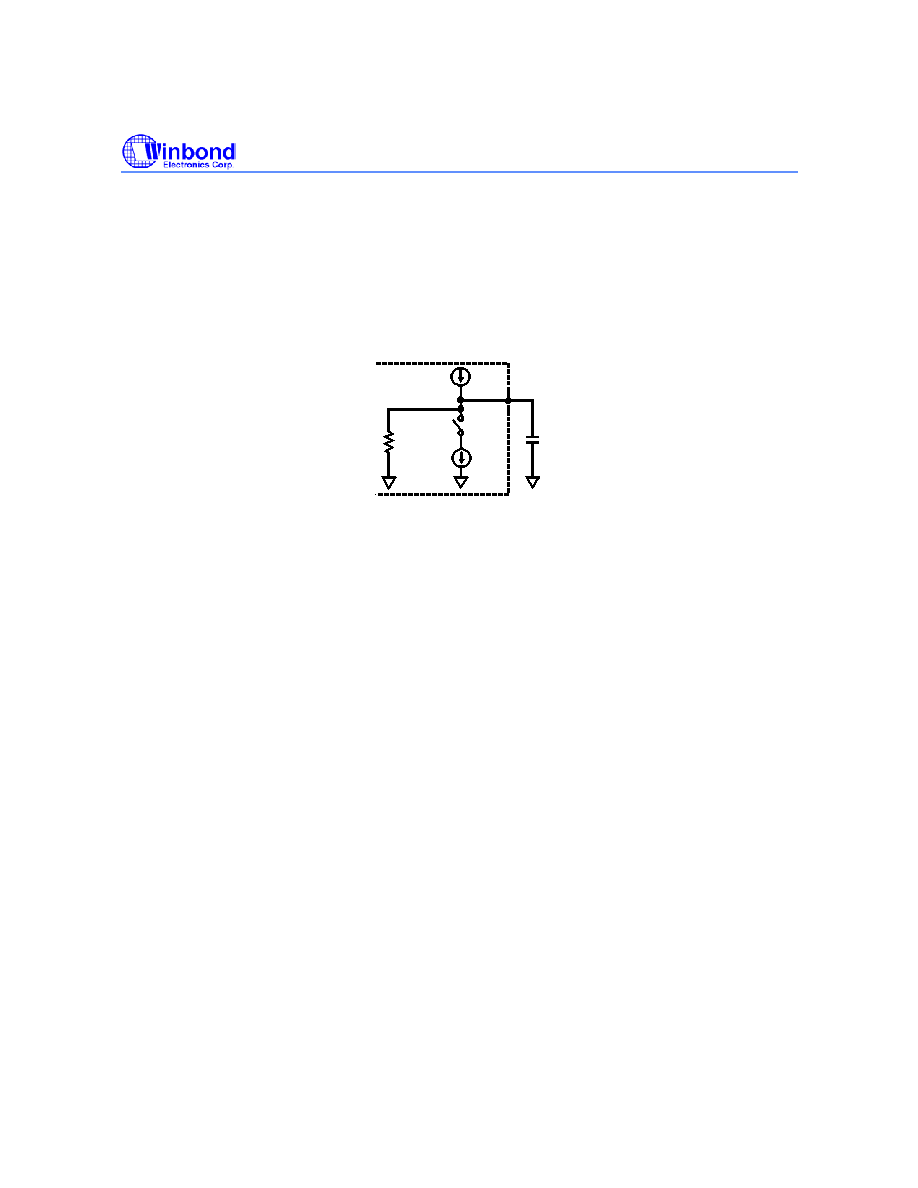- 您現(xiàn)在的位置:買賣IC網(wǎng) > PDF目錄68459 > W671361Y (WINBOND ELECTRONICS CORP) TELECOM-SLIC, QCC32 PDF資料下載
參數(shù)資料
| 型號: | W671361Y |
| 廠商: | WINBOND ELECTRONICS CORP |
| 元件分類: | 模擬傳輸電路 |
| 英文描述: | TELECOM-SLIC, QCC32 |
| 封裝: | QFN-32 |
| 文件頁數(shù): | 20/48頁 |
| 文件大小: | 1344K |
| 代理商: | W671361Y |
第1頁第2頁第3頁第4頁第5頁第6頁第7頁第8頁第9頁第10頁第11頁第12頁第13頁第14頁第15頁第16頁第17頁第18頁第19頁當(dāng)前第20頁第21頁第22頁第23頁第24頁第25頁第26頁第27頁第28頁第29頁第30頁第31頁第32頁第33頁第34頁第35頁第36頁第37頁第38頁第39頁第40頁第41頁第42頁第43頁第44頁第45頁第46頁第47頁第48頁

W671300 SERIES
7.2.3.1. Silent Polarity Reversal
Changing from Forward Active to Reverse Active or vice versa is referred to as polarity reversal. Many
applications require slew rate control of the polarity reversal event. Requirements range from
minimizing crosstalk to protocol signalling.
The device uses an external low voltage capacitor, CPOL, to set the reversal time. Once programmed,
the reversal time will remain nearly constant over various load conditions. In addition, the reversal
timing capacitor is isolated from the AC loop, so loop stability is not impacted.
The internal circuitry used to set the polarity reversal time is shown below.
C
PO
POL
I
1
75k
I
2
FIGURE 11: REVERSAL TIMING CONTROL
During Forward Active, the current from source I1 charges the external timing capacitor CPOL and the
switch is open. The internal resistor provides a clamping function for voltages on the POL node.
During Reverse Active, the switch closes and I2 (roughly twice I1) pulls current from I1 and the timing
capacitor. The current at the POL node provides the drive to a differential pair which controls the
reversal time (time) according to the following relationship.
CPOL
time
75000
----------------
=
(EQ. 54)
Polarized capacitors may be used for CPOL as the low voltage at the POL pin and minimal voltage
excursion of ±0.75V, are well suited to such capacitors.
7.2.3.2. Power Dissipation
The power dissipation equations for Forward Active operation described above also apply to Reverse
Active operation.
7.2.4. RINGING MODE
The Ringing mode (RNG, 100) provides linear amplification to support a variety of ringing waveforms.
A programmable Ring Trip function provides loop supervision and auto disconnect upon Ring Trip.
The device is designed to operate from the high battery during this mode.
7.2.4.1. Architecture
The device provides linear amplification to the signal applied to the Ringing Signal Input, VRS. The
Publication Release Date: March 2004
- 27 -
Revision 0.5
相關(guān)PDF資料 |
PDF描述 |
|---|---|
| W671310P | TELECOM-SLIC, PQCC28 |
| W671340P | TELECOM-SLIC, PQCC28 |
| W671352P | TELECOM-SLIC, PQCC28 |
| W671352Y | TELECOM-SLIC, QCC32 |
| W671371P | TELECOM-SLIC, PQCC28 |
相關(guān)代理商/技術(shù)參數(shù) |
參數(shù)描述 |
|---|---|
| W674 | 功能描述:燈 S-8 INCND S.C. BAY RoHS:否 制造商:Chicago Miniature 燈類型:Incandescent 燈座類型:Wire Terminal 燈大小:T-1 3/4 顏色: 電壓:14 V 工作電流: MSCP:0.3 MSCP 壽命:40000 hr 封裝:Bulk |
| W67-A1Q1-20 | 制造商:MA-COM 制造商全稱:M/A-COM Technology Solutions, Inc. 功能描述:Magnetic Hydraulic Circuit Breakers |
| W67-A1Q3-20 | 制造商:MA-COM 制造商全稱:M/A-COM Technology Solutions, Inc. 功能描述:Magnetic Hydraulic Circuit Breakers |
| W67-A1Q5-20 | 制造商:MA-COM 制造商全稱:M/A-COM Technology Solutions, Inc. 功能描述:Magnetic Hydraulic Circuit Breakers |
| W67-A1S1-20 | 制造商:MA-COM 制造商全稱:M/A-COM Technology Solutions, Inc. 功能描述:Magnetic Hydraulic Circuit Breakers |
發(fā)布緊急采購,3分鐘左右您將得到回復(fù)。